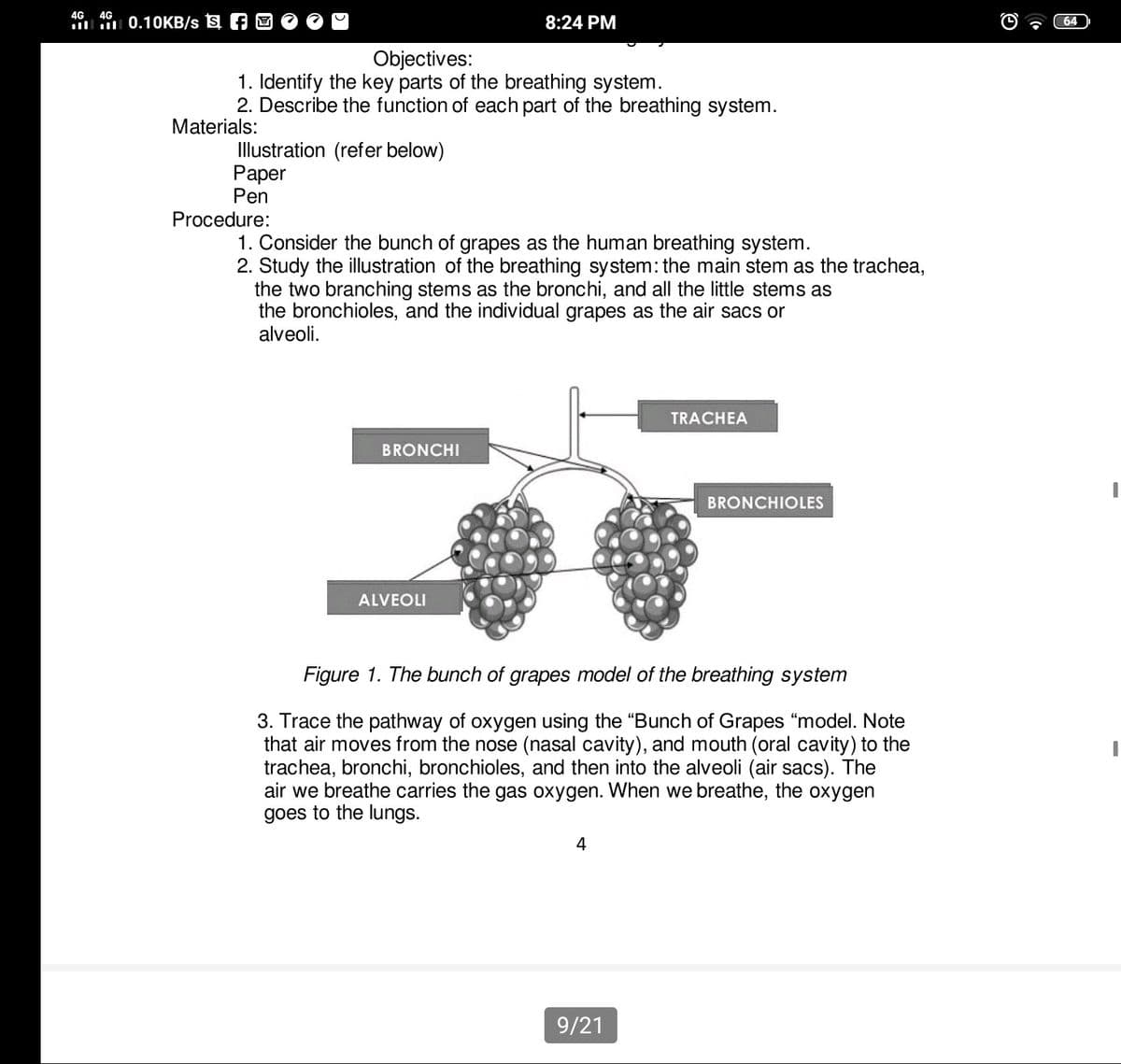Cardiopulmonary Anatomy & Physiology
7th Edition
ISBN:9781337794909
Author:Des Jardins, Terry.
Publisher:Des Jardins, Terry.
Chapter2: Ventilation
Section: Chapter Questions
Problem 15RQ: 15. Lung compliance study
Part /: If a patient generates a negative pleural pressure change of -8 cm...
Related questions
Question

Transcribed Image Text:4G 4G
i 0.10KB/s s
8:24 PM
64
Objectives:
1. Identify the key parts of the breathing system.
2. Describe the function of each part of the breathing system.
Materials:
Illustration (refer below)
Раper
Pen
Procedure:
1. Consider the bunch of grapes as the human breathing system.
2. Study the illustration of the breathing system: the main stem as the trachea,
the two branching stems as the bronchi, and all the little stems as
the bronchioles, and the individual grapes as the air sacs or
alveoli.
TRACHEA
BRONCHI
BRONCHIOLES
ALVEOLI
Figure 1. The bunch of grapes model of the breathing system
3. Trace the pathway of oxygen using the "Bunch of Grapes "model. Note
that air moves from the nose (nasal cavity), and mouth (oral cavity) to the
trachea, bronchi, bronchioles, and then into the alveoli (air sacs). The
air we breathe carries the gas oxygen. When we breathe, the
goes to the lungs.
охудen
4
9/21
Expert Solution
This question has been solved!
Explore an expertly crafted, step-by-step solution for a thorough understanding of key concepts.
Step by step
Solved in 3 steps

Knowledge Booster
Learn more about
Need a deep-dive on the concept behind this application? Look no further. Learn more about this topic, biology and related others by exploring similar questions and additional content below.Recommended textbooks for you

Cardiopulmonary Anatomy & Physiology
Biology
ISBN:
9781337794909
Author:
Des Jardins, Terry.
Publisher:
Cengage Learning,

Anatomy & Physiology
Biology
ISBN:
9781938168130
Author:
Kelly A. Young, James A. Wise, Peter DeSaix, Dean H. Kruse, Brandon Poe, Eddie Johnson, Jody E. Johnson, Oksana Korol, J. Gordon Betts, Mark Womble
Publisher:
OpenStax College

Basic Clinical Lab Competencies for Respiratory C…
Nursing
ISBN:
9781285244662
Author:
White
Publisher:
Cengage

Cardiopulmonary Anatomy & Physiology
Biology
ISBN:
9781337794909
Author:
Des Jardins, Terry.
Publisher:
Cengage Learning,

Anatomy & Physiology
Biology
ISBN:
9781938168130
Author:
Kelly A. Young, James A. Wise, Peter DeSaix, Dean H. Kruse, Brandon Poe, Eddie Johnson, Jody E. Johnson, Oksana Korol, J. Gordon Betts, Mark Womble
Publisher:
OpenStax College

Basic Clinical Lab Competencies for Respiratory C…
Nursing
ISBN:
9781285244662
Author:
White
Publisher:
Cengage

Biology: The Unity and Diversity of Life (MindTap…
Biology
ISBN:
9781305073951
Author:
Cecie Starr, Ralph Taggart, Christine Evers, Lisa Starr
Publisher:
Cengage Learning

Biology 2e
Biology
ISBN:
9781947172517
Author:
Matthew Douglas, Jung Choi, Mary Ann Clark
Publisher:
OpenStax